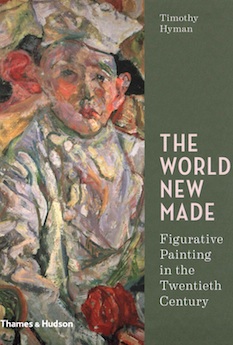By Svetlana Alpers
The book has, at first glance, the look of being part of a commissioned series—this or that topic in the history of art. It is presented, unfortunately, to my way of looking and reading, in the Thames & Hudson house style. That means that though the plates are colorful and good, the size and location of a work is not presented next to the image itself, but hidden away in the back matter. Not to know the size of something as one looks at an illustration of it is a serious deprivation.
On the other hand, within the constraints of the house format, the author is permitted to write free. Hyman has written a lively, argumentative, idiosyncratic account of figurative painting in the twentieth century. The precisely titled chapters (examples are “After Cubism”; “After Expressionism”; “First Person Painting”) are subdivided into shorter precisely titled sections devoted to a work by one or two artists. The organization has the virtue of freeing the author to focus. Again and again, there are riveting paragraphs devoted to looking at a painting. Hyman, himself also a painter in the exemplary English tradition of painter/critics, writes well and looks attentively. The text is exhilarating to read. His approach and choice of artists teach one a lot.
Hyman’s assumption is: “On the monochrome foundation of Cubism, formalists erected the great grey house of modern art.” Surprisingly, some might say refreshingly, he argues against Cubism and the abstraction he associates with it in the name of the political, social, personal engagement of artists as historical witnesses in what he calls a re-imagining. Early in the book, he praises Leger for turning against the lack of finish and ambiguities of modernist painting to address modern life with candor and directness. His Campers of 1954, the year before his death, showing a family on vacation, a picture new to me as so many are in the book, is an example. The Marsden Hartleys shown here are not the familiar landscapes but late figure paintings. Take the Fishermen’s Last Supper done at the end of his life, not in his home territory of Maine but in Nova Scotia. Here are the forceful, singular, iconic people who Hyman searches out. This unexpected painting is in a private collection.
It is characteristic of the range, openness, and independence of Hyman’s take on the art he loves that he found and quotes a fine tribute to Hartley by none other than Clement Greenberg: “There are and have been greater painters than Hartley, but few whose sentiment I value more. Sentiment is a dangerous terms nowadays, but I dare to insist on it as something that means the valuable, very valuable, when referred to an artist as sincere and true as he was.”
Clement Greenberg is known, unfairly pegged one might say, as the proponent of the anti-life abstraction that Hyman opposes. But he had a fine eye for painting of many kinds and times. Greenberg, like Hyman, could write. If Greenberg could see value in an art lacking the formal qualities he favored, why is Hyman so resistant (blind even) to what he refers to as the formal qualities in art—I would rather say the Art in art. The book does not make clear why figurative painting in our time cannot be one that looks out at the world rather than in, and why it cannot be strong in design, in other words pictorially strong. Piero della Francesca and Giovanni Bellini were figurative painters in Renaissance Italy who did just that.
German painters like Beckman and Dix attract Hyman for their immediate and almost graphic engagement with the bleak realities of the early twentieth century world. Here Hyman comments on Dix’s portrait of his parents: “Reproductions tend to smooth away the ruggedness of the awkward surface, in the smeared white patch along the father’s arm, for example, overlapping his striped shirt. We are made aware of Dix’s struggle, in the spirit of an early German ‘primitive’, to render solid and real each separate hand, limb, face—but artlessly without any trace of academic illusionism.”
Hyman’s taste, as with Dix, or with the American painters Alice Neel and Leon Golub, tends towards the art of northern Europe, in particular the greater German tradition. But there are luminous pages on Bonnard in France. Hyman has written a book on Bonnard and returns here to the core of his account. He is marvelous on the colors and depiction of light in the epiphanies that are the late works. His Bonnard belongs with what Hyman terms the first-person painters—others being Paula Modersohn-Becker and, perhaps surprisingly, Kirchner.
Artists such as Kubin, Tagore, Darger, Ken Kiff, and Bhuben Khakhar are also found here. Some names are new to me and certainly new to the serious looking they get from Hyman. His interest in inward-looking art also embraces “outsiders” like Darger who work free of any knowledge of the skills or traditions of art. Near the end, he turns back to William Kentridge. I say ‘back” because the Kentridge that Hyman celebrates is not the more public impresario of recent time. He looks at the extraordinary drawing/film-maker of the Felix Narratives (1989-2003) in which drawing erasing, redrawing, in a magical invention, address the artist’s selves in the South African world to which his Lithuanian Jewish family arrived as dispossessed.
Svetlana Alpers, an artist, critic and renowned art historian, is professor emerita of the history of art at the University of California, Berkeley and a visiting scholar in the Department of Fine Arts at New York University.




